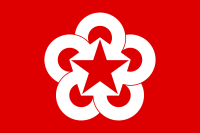Eastern Bloc
During the Cold War, the term Communist Bloc (or Soviet Bloc) was used to refer to the Soviet Union and countries it either controlled or that were its allies in Central and Eastern Europe (Bulgaria, Czechoslovakia, East Germany, Hungary, Poland, Romania, and—until the early 1960s—Albania).
The label "Eastern Bloc" was also used to collectively denote member states of the Warsaw Pact (a Soviet-dominated military organisation) or the Comecon (an international economic organization of Communist states). Allies outside of Eastern Europe, such as Mongolia and often China, Cuba, Vietnam, Ethiopia, and North Korea were sometimes included in the term Eastern Bloc as well.
The terms Eastern Bloc and Soviet Union are sometimes confused. Although the Soviet Union had much political and economic influence over its Eastern Bloc possessions, the other countries in the Eastern Bloc were never constituent republics of the Soviet Union.
Contents |
Yugoslavia, Albania
Yugoslavia was never part of the Eastern Bloc or the Warsaw Pact. Although it was a Communist state, its leader, Marshal Tito, came to power through his efforts as a partisan resistance leader during World War II, by deposing the Karadjordjevic dynasty without a popular referendum on the issue. Since he was not installed by the Soviet Red Army, he owed the Soviet leadership no allegiance. The Yugoslav government established itself as a neutral state during the Cold War, and the country was one of the founders of the Non-Aligned Movement.
Similarly, the Stalinist Albanian government also came to power independently of the Red Army as a consequence of Albanian partisan resistance during World War II. Albania broke with the Soviet Union in the early 1960s as a result of the Sino-Soviet split, aligning itself instead with the People's Republic of China and its anti-revisionist stance.
Use of force
Several countries in the Eastern Bloc became communist states as a result of force and the physical elimination of all political opposition to Soviet rule. Afterwards nations within the Eastern Bloc were held in the Soviet sphere of influence through military force. Hungary was invaded by the Soviet Army in 1956 after it had overthrown its pro-Soviet government and replaced it with one that sought a more democratic communist path independent of Moscow, when Polish communist leaders tried to elect Władysław Gomułka as First Secretary they were issued an ultimatum by Soviet military that occupied Poland ordering them to withdraw election of Gomulka for the First Secretary or be "crushed by Soviet tanks"[1]. Czechoslovakia was invaded in 1968 after a period of liberalization known as the Prague Spring. The latter invasion was codified in formal Soviet policy as the Brezhnev Doctrine.
Decline
During the late 1980s, the weakened Soviet Union gradually stopped interfering in the internal affairs of Eastern Bloc nations. Mikhail Gorbachev's abrogation of the Brezhnev Doctrine in favor of the so-called "Sinatra Doctrine" had dramatic effects across Central and Eastern Europe during this period. The Eastern Bloc eventually came to an end with the collapse of the Soviet controlled governments in Eastern Europe in 1989 (see Revolutions of 1989). The collapse of those governments led to the rapid transition to market economy in countries like Hungary, Poland, Czech Republic, Slovakia and Bulgaria.
Even before this period, all the countries in the Warsaw Pact did not always act as a unified bloc. For instance, the 1968 invasion of Czechoslovakia was condemned by Romania, which refused to take part in it.
Central and Eastern Europe
After 1989, the term Central and Eastern Europe (CEE) rather than Eastern Bloc came into wide use—from governmental cooperation, development organizations to businesses, but not to the extent of political parties.
Notes
See also
- Borduria, a fictional Eastern-Bloc country in the Tintin series
- Iron Curtain
- NATO
- Post-Soviet states
- Soviet Empire
- Western world
External links
- Photographs of Russia in 1967
- Candid photos of the Eastern Bloc September–December 1991, in the last months of the USSR
- Photographic project "Eastern Bloc" “Eastern Bloc” examines the specificities and differences of living in totalitarian and post totalitarian countries. The project is divided into chapters, each dedicated to one of the Eastern European countries—Slovak Republic, Poland, ex-GDR, Hungary, Czech Republic and ex-Yugoslavia.
|
|||||||||

